Botox Frequently Asked Questions: A Guide to A Younger and Smoother Appearance


When administered by a qualified medical expert, Botox is considered to be incredibly safe.
In the realm of cosmetic treatments, few options hold as much sway as Botox injections. Renowned for their ability to turn back the hands of time and bestow a revitalized, more youthful appearance, Botox treatments have garnered global acclaim for their effectiveness. If you’ve ever pondered the prospect of smoothing out wrinkles and rejuvenating your look, Botox could be the solution you’ve been seeking. Let’s delve into the world of Botox and unravel some of the most pressing questions surrounding this transformative procedure.
What Exactly Is Botox, and How Does It Work?
Botox, in essence, is a purified form of botulinum toxin type A. Now, before you let the word “toxin” send shivers down your spine, rest assured that when administered correctly, Botox is entirely safe. Its primary function is to temporarily relax the muscles responsible for “dynamic wrinkles”—those pesky lines that form when we make facial expressions like smiling or frowning. By calming these overactive muscles, Botox smooths out the appearance of wrinkles, particularly on the forehead, between the eyebrows (frown lines), and around the eyes (crow’s feet).
Does getting Botox hurt?
This is a common concern, but fear not! Most people find that Botox injections cause minimal discomfort. The needles used for Botox injections are lovely, so any sensation you might feel is usually very mild. Additionally, your practitioner can apply a numbing cream beforehand to make the experience even more comfortable.
How Long Will My Botox Results Last?
Ah, the million-dollar question! Typically, the effects of Botox last anywhere from 3 to 4 months. However, with regular treatments, you might notice that the results stick around for extended periods. It’s like training your muscles to stay relaxed and your skin to stay smoother for extended periods of time.
Are there any side effects I should be aware of?
Safety first, always! Botox is considered remarkably safe when administered by a qualified professional. As with any medical procedure, there can be some temporary side effects. These may include slight bruising, swelling, or perhaps a mild headache. But worry not. These effects are usually short-lived and subside quickly. Choosing an experienced injector who knows their stuff is essential to minimizing risks.
Am I a good candidate for Botox?
This is a vital question to consider. The best candidates for Botox are generally in good overall health and have realistic expectations about what the treatment can achieve. If you’re bothered by those expression lines—the ones that show up when you smile, frown, or squint—then Botox could be an excellent option for you. However, if you’re dealing with deeper wrinkles or sagging skin, you might benefit more from other treatments. A consultation with a professional at a reputable Med Spa can help you determine the best course of action for your unique needs.

Botox reduces wrinkles on the forehead, frown lines, and crow’s feet by relaxing these overactive muscles.
Welcome to Your Botox Destination: The Med Spa Experience
Now that we’ve covered the basics of Botox let’s talk about where you can embark on this journey to a smoother, more youthful you—the Med Spa. Here’s why the Med Spa experience stands out:
- Experienced Providers: Your safety and satisfaction are paramount at a reputable Med Spa. The skilled injectors here have undergone extensive training and possess the expertise needed to deliver exceptional results with the utmost care. Professional injectors have extensive training and are aware of the unique risks of injecting Botox into different areas of the face and different facial muscle structures. It is their job to determine how much Botox each patient needs, provide the appropriate dosage, and make sure the patient gets the most out of the therapy with the fewest possible adverse effects. Professionals in the medical and cosmetic fields can learn to inject Botox into high-risk areas with the help of Dentox. Seminars are available at various locations around the United States, and you can sign up for one in person, online, or at your convenience. For more information on our live courses and online botox training, please visit https://dentox.com/live-courses/ and https://dentox.com/all-courses/botox-training/, respectively.
- Tailored Approach: No two faces are alike, and neither are their aesthetic goals. Your concerns are heard and understood at a Med Spa, and your treatment plan is customized accordingly. Whether you want to soften a few lines or undergo a complete facial rejuvenation, the approach suits your needs and desires.
- Comprehensive Services: The beauty of a Med Spa lies in its ability to offer myriad aesthetic treatments under one roof. In addition to Botox, you can explore a range of complementary services, such as dermal fillers to plump and volumize or skin rejuvenation treatments to enhance and revitalize your complexion. Combining treatments can amplify your results and help you achieve a more comprehensive transformation.
In Conclusion
If you’re yearning for a smoother, more youthful appearance, Botox could be the answer you’ve been searching for. With its ability to temporarily relax muscles and diminish wrinkles, Botox has earned its reputation as a go-to cosmetic treatment for rejuvenation. Remember to seek a qualified professional, like those at a reputable Med Spa, to ensure a safe and satisfying experience. So why wait? Take the plunge and discover the transformative power of Botox for yourself—a radiant, more youthful you await!
Unlocking the Secrets of the Lip Flip: A Comprehensive Guide to Nonsurgical Lip Enhancement


A lip flip uses BOTOX®’s muscle-relaxant properties to enhance the top lip’s appearance.
In the world of cosmetic procedures, innovations continuously emerge, offering individuals opportunities to refine and redefine their appearances without invasive surgeries. One such innovation that has gained popularity in recent years is the lip flip. With the help of BOTOX® injections, this non-surgical procedure has the potential to subtly alter the upper lip by giving it a fuller and more defined contour. But what exactly is a lip flip, and how does it differ from traditional lip augmentation methods involving dermal fillers? In this comprehensive guide, we delve deep into the intricacies of the lip flip phenomenon, uncovering its procedure, benefits, potential risks, and everything in between.
Exploring the Lip Flip: A Path to Fuller Lips
At its essence, a lip flip constitutes a cosmetic intervention aimed at augmenting the aesthetic appeal of the upper lip through the utilization of the muscle-relaxant attributes of BOTOX®. In stark contrast to conventional lip augmentation methodologies reliant on the introduction of dermal fillers to augment lip volume, a lip flip concentrates on refining the configuration and topography of the upper lip while minimally impacting its dimensions. The procedure involves carefully injecting very small amounts of BOTOX® into the perioral musculature that surrounds the upper lip. This creates a subtle forward curve that makes the lips look fuller. This modality is notably advantageous for individuals contending with cosmetic concerns such as a hyperactive upper lip, insufficient lip demarcation, or facial asymmetry.
Understanding the Lip Flip Process: Steps, Expectations, and Outcomes
Commencing a lip-flip voyage entails a thoroughgoing process, commencing with an initial consultation with a certified medical practitioner. Throughout this inaugural encounter, individuals engage in comprehensive discussions concerning their objectives, medical background, and anticipated outcomes, thus establishing the groundwork for a bespoke treatment regimen. On the day of the procedure, the provider cleanses the treatment area before delicately administering the BOTOX® injections. While some may opt for topical anesthetics for added comfort, many find the procedure tolerable without them. Following the injection, individuals can resume their daily activities immediately, with minimal downtime. However, patience is paramount, as the full results of a lip flip may take several days to manifest, gradually unveiling a subtly transformed upper lip.
Deciphering the Nuances: Lip Flip vs. Lip Fillers
Distinguishing between a lip flip and traditional lip fillers is essential for individuals seeking the most suitable enhancement for their lips. Despite their shared goal of improving the lips’ appearance, the two procedures are quite different in the methods and aesthetic outcomes they intend to achieve. In order to improve the shape and contour of the upper lip, a lip flip mainly involves relaxing the muscles around it. But lip fillers, which use hyaluronic acid-based fillers, are all about making your lips look fuller and more defined, both on top and below the wrinkle. Lip fillers accommodate a wider range of tastes and demands than lip flips, which offer a subtler improvement with less recovery time and a more noticeable change in lip size and shape.
Advantages, Disadvantages, and Potential Dangers of the Lip Flip Lifestyle
The numerous advantages of a lip flip make it a tempting choice for those who want to subtly but dramatically improve the look of their lips. A lip flip is a great way to fix common beauty issues like uneven thickness or a lack of definition in the upper lip by making it look fuller and more defined. Plus, because it does not last forever, people can try different lip looks without committing to anything permanent. However, like any cosmetic procedure, a lip flip carries potential risks and considerations, including temporary side effects such as redness, swelling, or asymmetry. Choosing a qualified provider and adhering to post-procedure instructions are crucial steps in mitigating these risks and ensuring optimal outcomes.
Charting Your Lip Flip Journey: Consultation, Procedure, and Beyond
Embarking on a lip-flip journey necessitates thorough preparation and understanding of the process from start to finish. Beginning with a comprehensive consultation, individuals collaborate with their healthcare providers to articulate their goals, assess suitability, and customize a treatment plan tailored to their needs. On the day of the procedure, meticulous attention to detail ensures precise administration of BOTOX® injections, laying the groundwork for a successful outcome. Following the procedure, individuals navigate the post-treatment phase with diligence, adhering to guidelines, monitoring their progress, and scheduling follow-up appointments as needed to maintain their desired lip appearance.
Conclusion: Embracing the Power of the Lip Flip
In the realm of cosmetic enhancements, the lip flip stands as a testament to innovation and versatility, offering individuals a subtle yet transformative approach to lip enhancement. Through the strategic use of BOTOX® injections, this nonsurgical procedure unlocks the potential of the upper lip, bestowing it with a fuller, more defined contour that complements the natural beauty of the face. As individuals embark on their lip-flip journeys, guided by qualified professionals and armed with knowledge, they embrace the power to redefine their lips and enhance their confidence, one smile at a time.
When it comes to instructing patients in the art of efficient and precise Botox injections, Dentox is the go-to method for both medical and aesthetic specialists. Dentox offers a wide range of online learning alternatives and programs to professionals all across the US so they may learn at their own pace. Check out https://dentox.com/all-courses/botox-training for information on our virtual offerings and https://dentox.com/live-courses for details on our live courses. Get in touch with Dentox right away to start your path toward informed and purposeful cosmetic procedures.
Unlocking the Versatility of Neurotoxins: Beyond Wrinkles


Neurotoxins like Botox have long been used to smooth wrinkles and fine lines, but their potential goes beyond cosmetics.
Neurotoxins like Botox have long been lauded for their ability to soften wrinkles and fine lines, but their potential extends far beyond the realm of cosmetic enhancement. While commonly associated with treatments for the glabella, crow’s feet, and forehead, these potent agents have increasingly found utility in addressing both aesthetic and medical concerns, often in unexpected ways. While some applications may be considered “off-label,” when administered by skilled medical professionals, the use of neurotoxins proves to be safe and effective.
1. ‘Traptox’: Revolutionizing Aesthetics and Comfort
A burgeoning trend making waves across social media platforms like TikTok is the emergence of ‘Traptox.’ This innovative approach targets the trapezius muscle, a crucial yet often overlooked component of our musculoskeletal system. Spanning from the base of the skull to the mid-back and extending towards the shoulders, the trapezius muscle plays a pivotal role in maintaining posture and facilitating various movements of the head, neck, and shoulders.
So why the sudden interest in injecting neurotoxins into this area? The rationale behind ‘Traptox’ encompasses both therapeutic and cosmetic benefits. Firstly, individuals experiencing tension, stiffness, or discomfort in the neck and shoulders, often associated with overworked trapezius muscles, can find relief through neurotoxin injections. By blocking nerve signals, these injections induce muscle relaxation, alleviate pain, and enhance comfort.
Moreover, from an aesthetic standpoint, ‘Traptox’ offers the promise of sculpting the shoulders and creating the illusion of a more elongated neck. By impeding muscle contraction, neurotoxins contribute to muscle atrophy over time, leading to a reduction in size and a more slender appearance. This dual-action approach, addressing both functional discomfort and cosmetic enhancement, underscores the versatility of neurotoxins beyond their conventional applications.
2. Masseter Botox: Reshaping Faces and Relieving Tension
A technique gaining traction in recent years, Masseter Botox, colloquially known as ‘Jaw Botox,’ holds promise not only in reshaping facial contours but also in alleviating symptoms of temporomandibular joint (TMJ) disorder. The masseter muscle, responsible for jaw movement and the chewing process, can undergo hypertrophy, particularly among individuals prone to teeth grinding or clenching due to stress or TMJ issues.
By administering Botox into the masseter muscle, healthcare providers can mitigate muscle contraction, thereby easing tension and gradually reducing its size. Importantly, this intervention does not compromise jaw functionality, as Botox selectively targets the masseter muscle without affecting overall jaw movement. Patients may experience transient soreness or tenderness post-treatment, with optimal outcomes typically manifesting within 2–4 weeks.
For individuals seeking facial slimming, multiple sessions may be necessary to achieve the desired results. Nonetheless, Masseter Botox offers a minimally invasive solution for both cosmetic enhancement and therapeutic relief, underscoring its versatility in addressing multifaceted concerns.
3. Combatting Hyperhidrosis: A Refreshing Solution
Hyperhidrosis, characterized by excessive sweating stemming from overactive sweat glands, can significantly impact one’s quality of life, particularly in areas like the underarms, palms, and feet. While topical antiperspirants provide some relief, individuals with severe hyperhidrosis may require more robust interventions to manage their symptoms effectively.
Neurotoxins are becoming a new option for treating hyperhidrosis because they can help specifically by blocking the nerve signals that tell sweat glands to start working. Contrary to common misconceptions, injecting Botox does not lead to compensatory sweating in other areas of the body, assuring patients of localized efficacy.
The dosage of neurotoxin required varies depending on the treatment area, with some patients necessitating higher quantities to achieve optimal results. Though not permanent, the benefits of neurotoxin injections for hyperhidrosis typically last 4-6 months, providing respite from excessive sweating and restoring confidence in daily activities.
In conclusion, the utilization of neurotoxins transcends conventional boundaries, encompassing a spectrum of applications that extend beyond wrinkle reduction. From addressing musculoskeletal discomfort to refining facial contours and managing medical conditions like hyperhidrosis, the versatility of neurotoxins underscores their invaluable role in modern medicine and aesthetics. With careful administration by skilled professionals, these treatments offer a potent blend of efficacy, safety, and patient satisfaction, paving the way for enhanced well-being and self-assurance.
Dentox is the gold standard for aesthetic and medical professionals alike when it comes to teaching their patients how to inject Botox with precision and efficiency. Dentox gives professionals the freedom to learn at their own speed with a variety of online learning options, and classes spread out across the United States. Learn about our virtual offers at https://dentox.com/all-courses/botox-training and our live courses at https://dentox.com/live-courses. To begin your journey toward educated and meaningful cosmetic practices, contact Dentox now.
Botulinum Toxin: An Avenue of Relief for Temporomandibular Joint (TMJ) Afflictions


Botox injections treat the hyperactive muscles that cause symptoms like jaw clenching and grinding the teeth in the case of TMJ disorder.
A common condition known as temporomandibular joint disorder (TMJ) causes pain, dysfunction, and discomfort in the mandibular joint and surrounding musculature. Its manifestations can profoundly disrupt daily activities such as mastication, phonation, and sleep. Despite the array of treatment modalities available for TMJ, botulinum toxin, commonly known as Botox, has emerged as a promising therapeutic option, offering solace to sufferers. This article scrutinizes the mechanistic insights, efficacy, and merits of Botox injections in assuaging TMJ symptoms.
Comprehending Temporomandibular Joint Disorder (TMJ)
The temporomandibular joint (TMJ) serves as a pivotal hinge linking the mandible to the cranium, facilitating intricate movements, including chewing, speaking, and yawning. TMJ disorder encompasses a gamut of maladies affecting this joint and its contiguous musculature, ligaments, and nerves. Manifestations of TMJ encompass jaw pain or tenderness, impaired mandibular mobility, audible clicking or popping, and rigidity of the facial musculature.
Some of the things that can cause TMJ disorder are traumatic injuries to the mandible, bad teeth alignment, arthritic processes, bruxism, psychological stressors, or a combination of these. The intricate interplay of these factors renders TMJ disorder a complex entity, often necessitating a multidisciplinary therapeutic approach involving dentists, maxillofacial surgeons, physiotherapists, and other allied healthcare professionals.
Botulinum Toxin: Mechanism of Action and Therapeutic Potential
Botulinum toxin, derived from Clostridium botulinum, emerges as a potent neurotoxic protein renowned for its neuromuscular blocking properties. While its ingestion in substantial quantities can culminate in botulism, the therapeutic repertoire of botulinum toxin spans diverse medical disciplines encompassing neurology, ophthalmology, urology, and dermatology.
The mechanism of action of botulinum toxin revolves around its ability to impede the exocytosis of acetylcholine, a neurotransmitter pivotal for neuromuscular transmission, at the presynaptic membrane. By obviating acetylcholine release, botulinum toxin precipitates temporary muscle paralysis or debilitation, engendering muscle relaxation and ameliorating associated symptoms.
In the case of TMJ disorder, Botox injections target the hyperactive musculature, which is indicative of the condition’s hallmarks, such as exacerbated jaw clenching and bruxism. Botox injections are used to treat TMJ symptoms, specifically in muscles like the masseter and temporalis, that can become hypertonic or overactive due to several factors, such as stress and bad teeth grinding.
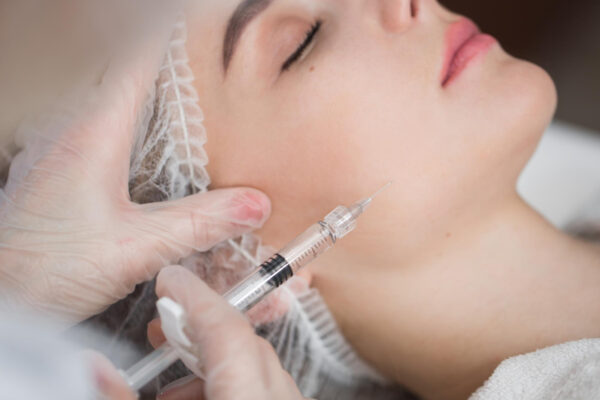
Injections of Botox, when administered by trained medical professionals, have an excellent safety profile.
Efficacy of Botox in Treating TMJ
A plethora of clinical investigations and anecdotal testimonies attest to the efficacy of Botox injections in assuaging TMJ-related distress. Empirical evidence corroborates the ability of Botox to mitigate muscle hyperactivity, alleviate pain, and enhance mandibular functionality among individuals grappling with TMJ disorder.
A systematic review and meta-analysis published in the Journal of Oral Rehabilitation looked at how well Botox injections relieve pain and dysfunction caused by TMJ. After studying, it was found that Botox treatments significantly decreased pain levels, improved mandibular mobility, and made patients happier compared to placebo or standard treatments.
Furthermore, Botox injections boast a commendable safety profile under the stewardship of adept healthcare practitioners. These interventions are typically well-tolerated, engendering minimal proclivity for systemic sequelae. Instances of localized adverse effects, such as transient muscular weakness or ptosis, are sporadic and evanescent in nature.
Benefits of Botox for TMJ Sufferers
There are several benefits to incorporating Botox into the treatment arsenal for TMJ disorder compared to more conventional methods. Firstly, Botox confers targeted and localized therapy, directly addressing the hyperactive musculature implicated in TMJ pathology. Botox does not go through the digestive system like oral drugs, so it has fewer systemic side effects and pharmacokinetic interactions.
Secondly, Botox offers a non-invasive alternative to surgical interventions for TMJ management. In severe or persistent cases of TMJ disorder, surgery like arthrocentesis or joint replacement may be necessary. However, Botox injections can be used instead of surgery, either as an additional treatment or as the main treatment for many patients.
Additionally, Botox injections for TMJ are expedient and facile, typically administered in outpatient settings. The interventions entail the judicious administration of fine-gauge needles, yielding minimal discomfort and convalescence for the recipient. Most individuals can promptly resume their daily activities post-procedure.
Moreover, the effects of Botox interventions for TMJ are transient and reversible, spanning approximately three to six months. This temporal attribute confers versatility in therapeutic planning and dosage titration, contingent upon individual responsiveness and symptomatology. Subsequent administrations can be tailored to sustain therapeutic efficacy over prolonged intervals.
Conclusion
Temporomandibular joint disorder (TMJ) constitutes a formidable challenge for afflicted individuals, encroaching upon their oral functionality, vital activities, and overall welfare. Amidst the panoply of therapeutic options available for TMJ, Botox injections have emerged as a promising therapeutic modality, assuaging the pain and dysfunction associated with the condition.
As part of its mechanism of action, Botox effectively targets the pathophysiological causes of TMJ disorder by reducing muscle hyperactivity. Empirical inquiries uniformly validate the potency of Botox in diminishing pain severity, enhancing mandibular functionality, and amplifying patient contentment.
Additionally, there is a slew of benefits to using Botox injections for TMJ, such as the fact that they are precise, non-invasive, convenient, and reversible. Botox has thus become an integral part of the interdisciplinary treatment plan for TMJ disorder, providing hope and relief to people all over the world.
Dentox serves as an epitome of expertise for professionals traversing both medical and aesthetic domains, furnishing comprehensive education on the precise and proficient administration of Botox injections. Boasting an array of conveniently situated classes spanning the expanse of the United States and flexible online learning avenues, Dentox empowers professionals to advance at their preferred pace. Discover live courses at https://dentox.com/live-courses and virtual offerings at https://dentox.com/all-courses/botox-training. Initiate contact with a certified Botox injector today to commence a voyage towards enlightened and impactful aesthetic practices.
Everything You Need to Know about Dermal Fillers
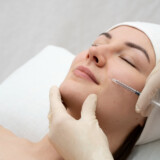
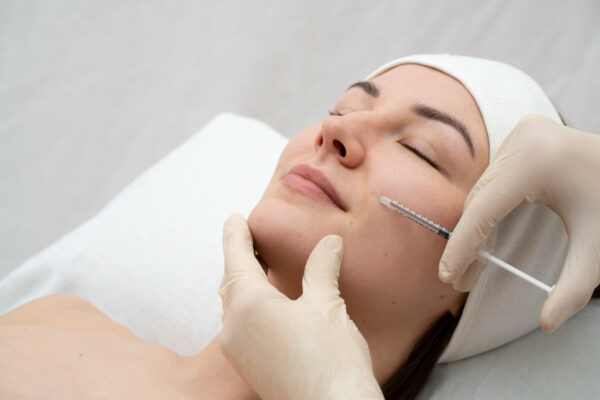
As a popular nonsurgical cosmetic treatment, dermal fillers fill in wrinkles, creases, and volume loss to make patients look younger.
Dermal fillers are a popular nonsurgical cosmetic treatment that restores fullness to the face by filling in wrinkles, lines, and volume loss, making patients look years younger. These injections, given by skilled healthcare professionals, entail strategically placing substances beneath the skin’s surface, typically focusing on the areas around the eyes, mouth, and nose. Renowned for their immediate and transformative results, dermal fillers have become a cornerstone of modern aesthetic medicine, allowing individuals to achieve a more youthful and rejuvenated appearance without invasive surgery.
Collagen is an essential protein that keeps skin supple and full as people age naturally, but their bodies produce less and less of it over time. Decreased collagen levels lead to sagging skin, diminished volume, and the appearance of wrinkles and creases. By restoring lost volume, improving face symmetry, and smoothing flaws, dermal fillers offer a multipurpose answer to these age-related alterations. When the skin on your face thins due to age, illness, or medicine, dermal fillers can make all the difference, giving you back a younger, fuller appearance.
What kinds of fillers are there for the skin?
Some different formulations of dermal fillers are available, so you can choose one that works best for you. The healthcare industry frequently uses commercially available fillers made of synthetic or naturally occurring ingredients. Fillers made of hyaluronic acid (HA) restore lost moisture and fullness to the skin for up to a year by increasing the skin’s natural supply of HA. Fillers made of calcium hydroxylapatite (CaHA), also found in bones, can treat deeper wrinkles and provide results that persist for about a year. The effects of poly-L-lactic acid (PLLA) fillers, which may last for two years or longer, are due to the stimulation of collagen production in the skin. Collagen and tiny spheres comprise polymethylmethacrylate (PMMA) fillers, which maintain their volume and stiffness beneath the skin’s surface for an extended period of time.
Details about the Procedure
Before undergoing a dermal filler procedure, individuals typically undergo a comprehensive consultation with a healthcare provider to evaluate their goals and suitability for treatment. A thorough medical history review, encompassing factors such as allergies, previous procedures, and existing skin conditions, is conducted to mitigate potential risks and ensure optimal outcomes. The skin is cleansed during the procedure, which may be performed in a clinical setting or a medical spa environment, and a local anesthetic is applied to enhance comfort. Subsequently, small quantities of filler are meticulously injected into predetermined areas using a fine-gauge needle, with most individuals experiencing minimal discomfort during the process.
After the treatment, the region will be carefully cleaned, and if you’re worried about swelling or pain after the injection, you can ask for an ice pack. Some people may experience moderate soreness, swelling, or bruising, but these side effects usually disappear after a few days. While the effects of dermal fillers tend to be noticeable immediately, the time it takes for them to take effect could vary from patient to patient and from area to area. Most people can return to their regular routines quickly following treatment, while heavy lifting and other physically demanding tasks may be temporarily discouraged to speed up the healing process.
Potential Hazards and Advantages
Despite the numerous benefits of dermal fillers, including immediate results, minimal downtime, and long-lasting effects, it is important to acknowledge and understand the potential risks and complications associated with these procedures. Adverse events such as asymmetrical appearance, bleeding, bruising, infection, skin damage, the formation of lumps or bumps, numbness, and rare vision problems may occur. Prompt medical attention should be sought if any concerning symptoms arise post-procedure, including bleeding, pain, signs of infection, or allergic reactions.
Key Takeaways
Dermal fillers are a popular cosmetic treatment choice for addressing age-related skin concerns, offering individuals a refreshed, more youthful appearance. By educating themselves about the procedure, available filler options, associated risks and benefits, and post-treatment care, people can make informed decisions to achieve their desired aesthetic results while ensuring safety and satisfaction. Under the administration of trained professionals, dermal fillers provide a transformative solution for those looking to improve their facial appearance and boost their overall confidence.
To ensure safe and effective dermal filler injections, it is recommended to consult with a certified professional. This helps prioritize the patient’s well-being and enhances the likelihood of achieving desired outcomes. Experienced injectors often develop personalized treatment plans to optimize results and minimize complications. Choosing high-quality filler options can yield natural-looking yet secure results.
Dr. Howard Katz heads the Dentox training program, which aims to assist medical professionals in enhancing patient comfort and recovery time during dermal filler injections. Interested individuals are encouraged to contact Dr. Howard Katz for information about the Dentox program. This comprehensive training equips medical professionals with essential skills to excel in administering dermal fillers and stay updated on advancements in the field.
Dentox provides dermal filler courses at https://dentox.com/all-courses/dermal-fillers/ for anyone looking for a reliable online training program. By participating in this program, medical professionals can be certain that they will learn everything they need to know to succeed in their field and keep up with all the newest developments. Check out https://dentox.com/live-courses/ if you’re interested in learning with real patients.
Why Is Filler Migration All the Rage Right Now?


Only trained medical professionals should perform cosmetic procedures because filler migration is a serious concern.
The buzz around filler migration has been growing, shedding light on this phenomenon that’s become a concern for many. Initially, dermal fillers seemed like routine cosmetic procedures, favored for their low risk and easy maintenance. However, recent discussions and trends on social media platforms like TikTok have brought filler migration to the forefront, sparking conversations about its potential risks and long-term effects.
But what exactly is filler migration? Simply put, it occurs when the filler injected into a specific area of the face or body shifts from its original placement. This movement can lead to various issues, from uneven texture and appearance to more severe complications like granulomas or nodules.
The rise of filler migration in public awareness can be attributed to several factors. The #FillerMigration trend on TikTok, which gained significant traction in late 2022, showcased firsthand accounts of individuals experiencing lip filler migration. Additionally, high-profile incidents like Kylie Jenner’s appearance at Paris Fashion Week earlier this year further fueled discussions about the implications of quick injectable procedures.
Understanding why filler migration happens is crucial. Factors like injection depth, tissue density, and muscle activity can all contribute to filler movement. For instance, injecting filler into superficial or loose fat tissue increases the likelihood of migration, especially in areas prone to frequent muscle movement, such as around the mouth or tear troughs.
Detecting filler migration isn’t always straightforward, but certain signs can indicate that the filler has shifted. These include unevenness in the injected area, changes in texture, or the appearance of filler in unintended areas. The Tyndall effect, characterized by a bluish discoloration under the eyes, is another common indicator of filler migration.
While filler migration may not always pose immediate dangers, addressing any concerns promptly is essential. In some cases, filler migration can lead to inflammation, tissue damage, or discomfort. Seeking treatment from a qualified professional is crucial, as improperly placed fillers can pose risks to vital structures like blood vessels.
Treatment options for filler migration include using hyaluronidase, an enzyme that dissolves hyaluronic acid fillers within 24 hours. This can effectively dissolve migrated filler and restore a natural appearance. Prevention is also crucial, with experts emphasizing the importance of seeking injections from certified professionals who prioritize patient safety and personalized treatment plans.
For medical professionals looking to enhance their skills in administering dermal fillers, training programs like Dentox offer valuable resources and education. By participating in courses tailored to dermal filler injections, professionals can stay updated on industry advancements and provide optimal patient care. Live classes are also available at https://dentox.com/live-courses/ for hands-on experience with actual patients. Ensuring practitioners are well-equipped to address filler migration and other concerns. Interested individuals seeking reliable training programs can visit https://dentox.com/all-courses/dermal-fillers/ to acquire the necessary knowledge and skills to excel in their fields while staying updated on industry advancements.
In conclusion, while filler migration may be a growing concern, it’s important to approach cosmetic procedures cautiously and seek treatment from qualified professionals. By understanding the causes and implications of filler migration, individuals can make informed decisions about their skincare treatments and prioritize safety and effectiveness.
Beauty Tipping Trends: Decisions, Norms, and Personal Choices


The decision about how much to tip for medical and cosmetic services can be complicated for some reasons.
The decision to tip for beauty and medical services can be confusing due to various factors. While tipping is generally not recommended for medical procedures like Botox injections, it becomes more common in non-medical beauty treatments such as facials and massages. The key is to consider the nature of the service, the service provider’s role, and your personal preferences.
Tipping a Botox injector is generally discouraged as it may compromise the professionalism of the medical field. Federal laws in the United States discourage medical practitioners from accepting gratuities. However, the tipping scenario gets more nuanced for non-medical beauty treatments provided at spas and salons. Whether a treatment is medical depends on who administers it—a licensed medical professional or an aesthetician. The general guideline is no tipping for medical offices or medical spas attached to a practice.
Tipping is customary for non-medical beauty services like massages, lash extensions, and microblading. However, tipping amounts are subjective, typically ranging from 15 to 20 percent of the pre-tax service cost. Beauty industry workers usually receive hourly wages with the expectation of receiving customer tips. Although tipping is discretionary, it is a common practice and contributes to the overall income of service providers.
Tipping is generally expected for beauty service providers who work independently, such as lash technicians. These individuals are not considered business owners who profit from services provided by others. While there are no strict rules regarding tipping, it’s a customary and gracious gesture to express gratitude for the services received.
Ultimately, tipping decisions depend on personal preferences, industry norms, and the nature of the service. Clients may adjust tip amounts based on the quality of service, but tipping is generally considered a standard practice in the beauty industry. It’s essential to be aware of the role of the service provider, as tipping expectations vary for medical and non-medical beauty treatments.
The finest Botox training programs will equip aspiring injectors with the skills needed for a successful career in the cosmetics industry. Enroll in a course now to master the sought-after technique of Botox administration under the guidance of experts. With dedication, you can unlock the full potential of Botox, leaving a lasting impression on every client who walks through your doors.
Dentox provides a comprehensive training program to instruct medical and cosmetic practitioners on the best practices for delivering Botox injections to their clients. With Dentox’s support, you can expand your business and enhance the care you provide to your clientele.
Dr. Howard Katz is widely acknowledged as the foremost authority in injectable training. He imparts his expertise to aspiring practitioners in a traditional classroom setting or through online platforms. Dentox facilitates Botox training through both online courses and in-person sessions, offering flexibility to learners. Online courses can be accessed at https://dentox.com/all-courses/botox-training/, while information on live courses is available at https://dentox.com/live-courses/.
Embracing Graceful Aging through Filler Facelifts: Navigating the Path to Radiant Youthfulness


Filler facelifts sharpen and reshape the jawline, counteract gravity descent, and create a more youthful appearance without surgery.
The process of aging unfolds as a natural and graceful journey, accompanied by the accumulation of wisdom, rich experiences, and a tapestry of memories. However, for many individuals, the indelible marks of aging etched upon their visages narrate a tale they aspire to reframe. The pursuit of a youthful visage has instigated the evolution of diverse cosmetic interventions, with the filler facelift emerging as a pioneering solution. This non-surgical modality adeptly addresses wrinkles, volumetric diminishment, and gravitational tissue descent, pledging to reinstate youthful vibrancy without the necessity for intrusive interventions.
Unleashing Organic Metamorphosis via Dermal Fillers
Dermal fillers, heralded as paragons within the realm of injectables, encompass an amalgamation of diverse bioactive compounds, prominently featuring hyaluronic acid. These fillers offer a non-invasive remedy for a spectrum of aging indicators, orchestrating an organic metamorphosis that revitalizes the integumentary canvas. Let us delve into the mechanisms by which filler facelifts exert their enchantment:
- Smoothing Wrinkles & Lines: Dermal fillers strategically target facial rhytids, nasolabial furrows, and marionette lines, efficaciously ameliorating their manifestation. The outcome manifests as a velvety, more youthful countenance, obviating the necessity for intrusive surgical interventions.
- Restoration of Lost Volume: Aging invariably precipitates the depletion of volume in regions such as the malar prominences, temples, and infraorbital zones. Dermal fillers function as restitutional agents, replenishing the vacated plenitude, thereby imparting definition and sculpting facial contours to impart a lifted aesthetic.
- Lip Augmentation: Dermal fillers serve as artful tools for augmenting thin lips, delineating their borders, and creating a naturally fuller, more sensuous pout. This enhancement bestows a nuanced yet impactful transformation upon the entirety of the countenance.
- Definition of the Jawline: Sagging of the mandibular contour emerges as a prevalent concern in the aging process. Filler facelifts assume the mantle of sharpening and redefining the jawline, counteracting gravitational descent, and crafting a more youthful visage, all without recourse to surgical procedures.
Transcending Wrinkles: Tailored Modalities for Individualized Transformation
The differentiating feature of filler facelifts from conventional facelifts resides in their capacity to furnish bespoke solutions. Each variant of filler is meticulously formulated to address distinct aging predicaments, thereby facilitating the crafting of personalized treatment regimens tailored to individual exigencies and aesthetic aspirations. This tailoring ensures that the resultant transformations manifest as harmonious complements of the individual’s inherent features.
- Customization: The myriad options in filler formulations afford the latitude for a bespoke approach in mitigating specific aging manifestations. Be it fine lines, volumetric loss, or lip augmentation, a proficient practitioner can sculpt a treatment plan precisely aligned with the patient’s requisites.
- Minimal Downtime: Unlike their surgical counterparts, which necessitate extended convalescence periods, filler treatments entail minimal downtime. Patients can promptly resume their daily routines, making it convenient for those navigating demanding schedules.
- Naturalistic Outcomes: A primary apprehension surrounding cosmetic interventions is the apprehension of an exaggerated appearance. Filler facelifts dispel such concerns, rendering outcomes that are inherently naturalistic, elevating features without precipitating radical alterations. This preserves the innate beauty and expressiveness of the individual.
- Gradual Advancement: Certain fillers elicit collagen synthesis, engendering enduring, naturally evolving outcomes. This gradual progression ensures that the metamorphosis is not only immediate but also sustained over time.
Sustaining Optimal Outcomes
It is imperative to acknowledge that, while filler facelifts yield impressive results, they do not embody panaceas. To optimize and prolong the benefits, adhering to a health-centric lifestyle assumes paramount importance. This entails adopting a nutritive diet, engaging in regular physical activity, and adhering to a consistent skincare regimen. These practices synergistically complement the filler facelift, contributing to sustained and optimal outcomes.
Specialized Training for Medical Practitioners
For medical professionals aspiring to augment their proficiency in cosmetic interventions, Dentox presents an exclusive training program. Tailored to empower professionals with adeptness in crafting personalized treatment plans utilizing Botox and dermal fillers, these courses, spearheaded by Dr. Howard Katz, furnish invaluable insights into the latest advancements in the field.
For those seeking virtual instruction, Dentox offers comprehensive courses in dermal fillers (https://dentox.com/all-courses/dermal-fillers/) and Botox (https://dentox.com/all-courses/botox-training/). These courses are meticulously curated to equip professionals with indispensable competencies while ensuring they remain abreast of contemporary industry developments.
For aficionados of hands-on experience, Dentox presents live classes (https://dentox.com/live-courses/) wherein participants engage with actual patients, thereby acquiring practical knowledge and fortifying their self-assurance.
In Conclusion
The filler facelift heralds a revolutionary paradigm in embracing the process of aging gracefully, offering organic and personalized resolutions devoid of surgical interventions. Through the utilization of dermal fillers, individuals can seamlessly ameliorate wrinkles, replenish lost volume, augment lips, and redefine their jawline—all while safeguarding their intrinsic beauty and expressions. As the demand for non-surgical cosmetic interventions continues its ascent, specialized training programs, such as those offered by Dentox, emerge as indispensable for medical professionals endeavoring to excel in this dynamic field. Embrace the journey of aging with sophistication, assurance, and a redefined natural radiance through the artistry of filler facelifts.
Navigating Post-Botox Protocol: 8 Medical Insights on What to Avoid After Treatment
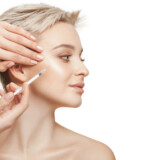
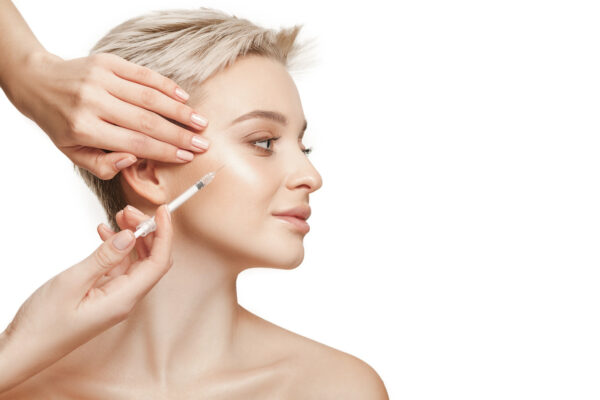
Maximizing results and minimizing issues after Botox injections depends on following proper post-treatment care instructions.
Botox, a neurotoxin derived from Clostridium botulinum, has revolutionized the field of aesthetic medicine, offering a minimally invasive solution to combat wrinkles and fine lines. While the procedure is generally safe and effective, proper post-botox care is crucial to ensure optimal results and minimize potential complications. This comprehensive guide delves into eight critical considerations rooted in medical insights, outlining what you should never do right after receiving Botox injections.
Avoid Massaging the Treated Area
Following a Botox treatment, it is imperative to refrain from massaging or rubbing the injected area. Botox works by temporarily blocking nerve signals that cause muscle contractions, and massaging the treated site can spread the neurotoxin to unintended areas. This could lead to unwanted muscle weakness or drooping. Patience is key, as it takes time for the neurotoxin to settle into the targeted muscles and exert its smoothing effects.
Say No to Strenuous Exercise
Engaging in strenuous physical activities immediately after a Botox session is discouraged. Intense exercise increases blood circulation and may inadvertently distribute the neurotoxin to neighboring muscles. Opt for a gentle workout routine for the first 24 hours to minimize the risk of compromising the treatment’s precision. This precautionary measure aligns with the principle of averting systemic dissemination of the neurotoxin.
Steer Clear of Alcohol Consumption
Alcohol consumption has vasodilatory effects, meaning it widens blood vessels. This can potentially heighten the risk of Botox migration from the injection site. Additionally, alcohol’s blood-thinning properties may contribute to increased bruising at the injection sites. For optimal results, it is advisable to abstain from alcohol for at least 24 hours post-Botox.
Refrain from Heat Exposure
Exposing the treated area to excessive heat, whether from saunas, hot tubs, or prolonged sun exposure, can intensify the risk of swelling and inflammation. Heat can exacerbate the dilation of blood vessels, potentially causing the Botox to disperse. Patients are advised to avoid hot environments for the first day or two following the procedure to safeguard the targeted effects of the neurotoxin.
Say ‘No’ to Blood-Thinning Medications
Some medications, like non-steroidal anti-inflammatory drugs (NSAIDs) and aspirin, have blood-thinning properties that may heighten the risk of bruising and bleeding at the injection sites. It is recommended to consult with your healthcare provider before using any medications after Botox to ensure they do not interfere with the effectiveness of the neurotoxin or compromise the healing process.
Do Not Schedule Facials or Chemical Peels Immediately
On the days following a Botox treatment, it is recommended that facial treatments, chemical peels, or laser therapies be avoided. These procedures can potentially irritate the treated skin and heighten the risk of adverse reactions. To avoid complications, waiting at least two weeks before scheduling any facial rejuvenation treatments after receiving Botox injections is advisable.
Resist the Urge to Over-Express Facial Muscles
While Botox is designed to relax specific muscles, continuously over-expressing facial expressions immediately after treatment may compromise its efficacy. Practice moderation and allow the neurotoxin to work its magic without unnecessary strain on the treated muscles. This precaution aids in ensuring the longevity of the results and preventing unintended consequences.
Refrain from Sleeping in an Upright Position
Maintaining an upright sleeping position for the first-night post-Botox is advised. This helps prevent unintended pressure on the treated areas, reducing the risk of an uneven distribution of the neurotoxin. Sleeping in an elevated position, such as with an extra pillow, can contribute to a more favorable outcome and minimize the potential for complications.
Key Takeaways
Adhering to appropriate post-Botox care is essential for maximizing results and reducing potential complications. Following these eight medical insights, based on a thorough understanding of the neurotoxin’s mechanism and possible interactions, will enhance recovery, leading to lasting benefits. Always seek personalized guidance from your healthcare provider, tailored to your specific needs and medical history. By being attentive to these post-Botox considerations, individuals can confidently navigate the recovery journey, ensuring their appearance’s sustained freshness and rejuvenation.
For healthcare professionals looking to enhance their expertise in cosmetic procedures, Dentox introduces an exclusive training program. This program is designed to empower professionals with proficiency in creating personalized treatment plans using Botox and dermal fillers. Spearheaded by Dr. Howard Katz, these courses provide invaluable insights into the latest advancements in the field.
For those searching for virtual instruction, Dentox offers comprehensive courses in dermal fillers (https://dentox.com/all-courses/dermal-fillers/) and Botox (https://dentox.com/all-courses/botox-training/). These courses are carefully curated to equip professionals with essential skills, ensuring they stay updated on contemporary industry developments.
For enthusiasts of hands-on experience, Dentox presents live classes (https://dentox.com/live-courses/) where participants actively engage with actual patients, acquiring practical knowledge and strengthening their self-assurance. Explore dermal fillers and Botox courses to elevate your skills and stay at the forefront of cosmetic medicine.
Unveiling the Artistry of Dermal Fillers: Enhancing Lips and Rejuvenating the Face


Lip fillers are a popular choice for individuals seeking fuller and more shapely lips.
Dermal fillers have emerged as transformative agents in the realm of aesthetic enhancement, offering a non-invasive and versatile solution to restore volume, smooth lines, and rejuvenate facial contours. These injectable substances have become particularly popular for their effectiveness in various facial areas, including the lips, cheeks, nasolabial folds, and marionette lines. In this exploration of dermal fillers, we delve into the intricacies of lip and facial treatments, unraveling the science behind these procedures and the artistry they bring to achieving a more youthful appearance.
Lip Fillers: A Symphony of Shape and Volume
Lip fillers, also known as lip augmentation or lip injections, are a sought-after solution for those desiring fuller, shapelier lips. The procedure involves the injection of dermal fillers, typically composed of hyaluronic acid, a natural substance that attracts and retains moisture, providing a plumping effect. The injections are administered with precision, targeting specific areas of the lips to add volume, define the lip border, and improve symmetry.
One of the remarkable features of lip fillers is their immediate impact, granting individuals the gratification of witnessing their enhanced lips almost instantaneously. The longevity of results varies, typically lasting between 6 months and 1 year, contingent upon the type of filler used and individual metabolism. This makes lip fillers an ideal choice for those seeking a temporary enhancement with the flexibility to adapt their look over time.
Cheek Fillers: Elevating Contours and Reversing Time
Cheek fillers, also known as cheek augmentation or mid-face fillers, address the natural aging process that leads to the loss of fat pads in the cheeks, resulting in hollowing and sagging. Dermal fillers, often containing hyaluronic acid or calcium hydroxylapatite, are skillfully injected into the cheeks to restore volume and improve contouring.
By lifting and rejuvenating the midface, cheek fillers contribute to a more youthful appearance. The results are both natural-looking and enduring, with effects lasting up to 1 to 2 years, depending on the specific filler chosen. This extended duration makes cheek fillers an appealing option for those seeking a more sustained revitalization of their facial features.
Nasolabial Fold Fillers: Easing Laughter Lines for Timeless Elegance
Nasolabial folds, colloquially known as smile lines or laugh lines, represent a common concern for individuals seeking to minimize the visible signs of aging. Dermal fillers containing hyaluronic acid or collagen stimulators are employed to soften and smooth these lines, restoring a more youthful appearance.
The injection of fillers into nasolabial folds adds volume and support, reducing the depth of the lines and rejuvenating the surrounding facial area. Results typically last between 6 months and 1 year, providing individuals with a refreshed and vibrant look that reflects their timeless elegance.
Marionette Line Fillers: Uplifting the Downturned Aesthetic
Marionette lines, extending from the corners of the mouth down to the chin, can impart a downturned appearance to the mouth, contributing to an aged look. Dermal fillers, commonly containing hyaluronic acid or collagen stimulators, serve to soften and lift these lines, restoring a more youthful contour to the lower face.
Injected strategically into marionette lines, the fillers add volume and support, mitigating the sagging appearance and rejuvenating the lower face. Results are typically seen for 6 months to 1 year, offering individuals an effective solution for uplifting their facial aesthetic without the need for invasive procedures.
The Versatility of Dermal Fillers: Tailoring Enhancement to Individual Aesthetics
Dermal fillers for lips and the face embody a versatile and effective approach to aesthetic enhancement and rejuvenation. These treatments offer immediate results with minimal downtime, allowing individuals to resume their daily activities promptly. The adaptability of dermal fillers is particularly noteworthy, as healthcare providers can tailor treatments to each individual’s unique anatomy and aesthetic goals.
It is imperative to emphasize the importance of consulting with a qualified and experienced healthcare provider when considering dermal fillers. A skilled practitioner can assess individual needs, discuss expectations realistically, and recommend the most appropriate filler type and treatment plan. This collaborative approach ensures optimal results and a positive aesthetic journey for those seeking to enhance their lips and rejuvenate their facial features.
In the symphony of aesthetic enhancement, dermal fillers play a harmonious role, offering individuals the opportunity to sculpt and refine their facial contours. Whether addressing the lips, cheeks, nasolabial folds, or marionette lines, these injectable solutions bring both science and artistry to the forefront, empowering individuals to embrace a more youthful and revitalized version of themselves.
The Dentox training program is highly recommended for medical practitioners involved in administering dermal fillers, with a focus on addressing potential risks and optimizing patient outcomes. This comprehensive program not only imparts in-depth knowledge but also emphasizes practical skills, with a strong commitment to minimizing patient discomfort and streamlining the recovery process during filler administrations.
For those eager to explore the intricacies of dermal fillers, a wealth of online resources awaits at https://dentox.com/all-courses/dermal-fillers/. Participating in this program not only enables medical professionals to stay updated on the latest developments in their respective fields but also positions them as experts in the realm of dermal fillers.
Live classes, providing participants with the opportunity to interact with actual patients, are also accessible at https://dentox.com/live-courses/. This hands-on experience adds a valuable dimension to the learning process, offering insights into the practical application of dermal filler techniques. Enrolling in Dentox’s live courses presents a unique chance to observe and engage in real-world scenarios, thereby enhancing proficiency in the field of dermal fillers.





